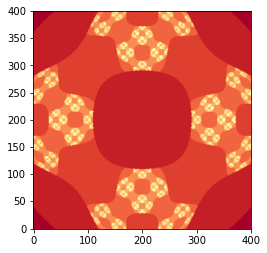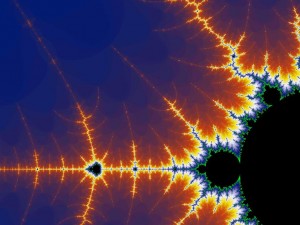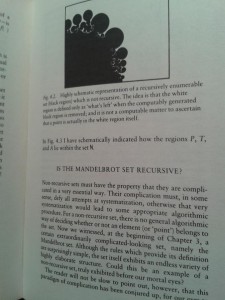Introduction
In July 2018 professor Zvonko Iljazović and myself have attended the CCA 2018 conference and presented our joint work titled "Effective compactness and uniqueness of maximal computability structures". The original presentation can be found here.
Computability structures
In the following I will mention the elements of the theory of computability structures needed to state our main result. These notions are already well known, the main contributing articles for this theory that were used for our work are listed in the references.
Let ![]() be a metric space and
be a metric space and ![]() a sequence in
a sequence in ![]() . We say
. We say ![]() is an effective sequence in
is an effective sequence in ![]() if the function
if the function ![]()
![]()
is recursive.
A finite sequence ![]() is an effective finite sequence if
is an effective finite sequence if ![]() is a recursive real number for each
is a recursive real number for each ![]() .
.
If ![]() and
and ![]() are sequences in
are sequences in ![]() , we say
, we say ![]() is an effective pair in
is an effective pair in ![]() and write
and write ![]() if the function
if the function ![]() ,
,
![]()
is recursive.
Let ![]() be a metric space and
be a metric space and ![]() a sequence in
a sequence in ![]() . A sequence
. A sequence ![]() is computable w.r.t
is computable w.r.t ![]() in
in ![]() iff there exists a computable
iff there exists a computable ![]() such that
such that
![]()
for all ![]() . We write
. We write ![]() .
.
Let ![]() be a metric space. A set
be a metric space. A set ![]() is a computability structure on
is a computability structure on ![]() if the following holds:
if the following holds:
 , then
, then 
- if
 and
and  , then
, then 
We say ![]() is a computable point in
is a computable point in ![]() iff
iff ![]() .
.
A computability structure ![]() such that there exists a dense sequence
such that there exists a dense sequence ![]() is called separable.
is called separable.
We say ![]() is a maximal computability structure on
is a maximal computability structure on ![]() if there exists no computability structure
if there exists no computability structure ![]() such that
such that ![]() and
and ![]() .
.
The main question
The main question we are asking and trying to answer is the following:
Question:Let ![]() be a metric space. Let
be a metric space. Let ![]() . Let
. Let ![]() be a maximal computability structure in which
be a maximal computability structure in which ![]() are computable. Under which conditions is such
are computable. Under which conditions is such ![]() unique?
unique?
A known result for sub-spaces of the Euclidean space
Let ![]() be a real vector space. Let
be a real vector space. Let ![]() be vectors in
be vectors in ![]() . We say that
. We say that ![]() are geometrically independent points if
are geometrically independent points if ![]() are linearly independent vectors.
are linearly independent vectors.
Let ![]() . The largest
. The largest ![]() such that that there exist geometrically independent points
such that that there exist geometrically independent points ![]() we call the affine dimension of
we call the affine dimension of ![]() , and write
, and write ![]() .
.
The following result from [1] already answers the main question in the case where ![]() is a sub-space of the Euclidean space.
is a sub-space of the Euclidean space.
Theorem: Let ![]() ,
, ![]() and
and ![]() . If
. If ![]() is a geometrically independent effective finite sequence on
is a geometrically independent effective finite sequence on ![]() then there exists an unique maximal computability structure on
then there exists an unique maximal computability structure on ![]() in which
in which ![]() are computable points.
are computable points.
Main result for more general metric spaces
We wanted to introduce for general metric spaces a notion which will be a sort of replacement to the notion of geometric independence.
In the original presentation we used the term nice sequence. It turns out that this notion is a special case of the well-known notion of a metric base.
Let ![]() be a metric space. A subset
be a metric space. A subset ![]() is called a metric base for
is called a metric base for ![]() iff for all
iff for all ![]() the following implication holds:
the following implication holds: ![]() for all
for all ![]() implies
implies ![]() .
.
A metric space ![]() is said to be effectively compact if there exist an effective separating sequence
is said to be effectively compact if there exist an effective separating sequence ![]() in
in ![]() and a computable function
and a computable function ![]() such that
such that
![]()
for each ![]() . It is known that if
. It is known that if ![]() is effectively compact, then for each effective separating sequence
is effectively compact, then for each effective separating sequence ![]() in
in ![]() there exists such a computable function
there exists such a computable function ![]() .
.
A metric base is exactly the notion we needed to obtain the following result, at least for effectively compact metric spaces.
Theorem: Let ![]() be an effectively compact metric space. Suppose
be an effectively compact metric space. Suppose ![]() is a metric base in
is a metric base in ![]() and suppose that there exists a separable computability structure
and suppose that there exists a separable computability structure ![]() on
on ![]() in which
in which ![]() are computable points. Then
are computable points. Then ![]() is a unique maximal computability structure on
is a unique maximal computability structure on ![]() in which
in which ![]() are computable points.
are computable points.
In fact, an even more general form of the theorem holds: the assumption of effective compactness of the space ![]() can be replaced with the assumption that
can be replaced with the assumption that ![]() has compact closed balls and there exists
has compact closed balls and there exists ![]() such that the computable metric space
such that the computable metric space ![]() has the effective covering property.
has the effective covering property.
Proofs will be presented in our future up-coming publication.
References
- Zvonko Iljazović. Isometries and Computability Structures. Journal of Universal Computer Science, 16(18):2569--2596, 2010.
- Zvonko Iljazović and Lucija Validžić. Maximal computability structures. Bulletin of Symbolic Logic, 22(4):445--468, 2016.
- Alexander Melnikov. Computably isometric spaces. Journal of Symbolic Logic, 78:1055--1085, 2013.
- Marian Pour-El and Ian Richards. Computability in Analysis and Physics. Springer-Verlag, Berlin-Heielberg-New York, 1989.
- Klaus Weihrauch. Computable Analysis. Springer, Berlin, 2000.
- M. Yasugi, T. Mori and Y. Tsujji. Effective properties of sets and functions in metric spaces with computability structure. Theoretical Computer Science}, 219:467--486, 1999.
- M. Yasugi, T. Mori and Y. Tsujji. Computability structures on metric spaces. Combinatorics, Complexity and Logic Proc. DMTCS96 (D.S.~Bridges et al), Springer, Berlin}, 351--362, 1996.
Copyright © 2018, Konrad Burnik







![Rendered by QuickLaTeX.com \[\chi_S(x) =\begin{cases} 1, & x \in S \\ 0, & x \not \in S \end{cases}\]](https://konrad.burnik.org/wordpress/wp-content/ql-cache/quicklatex.com-064bd0cca97592aa71745aad2444c6ab_l3.png)